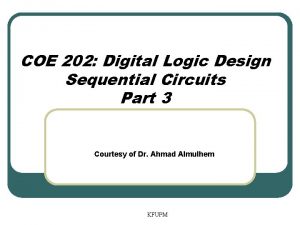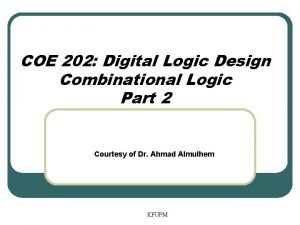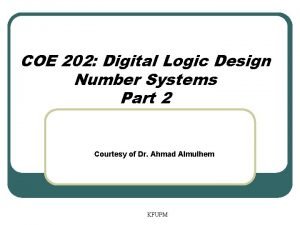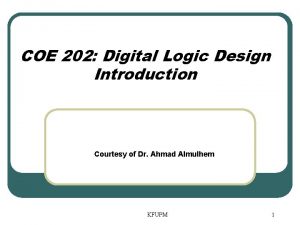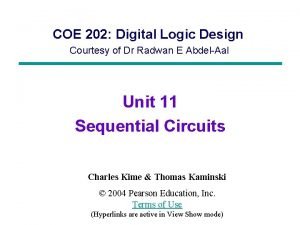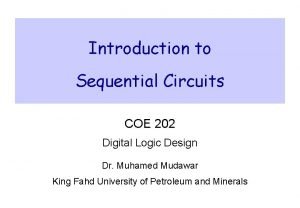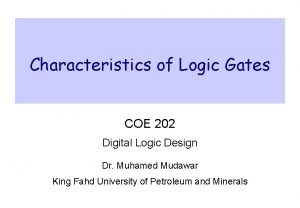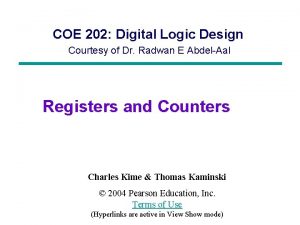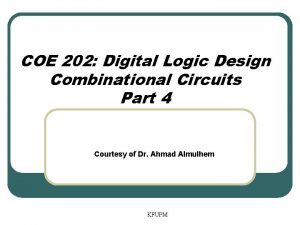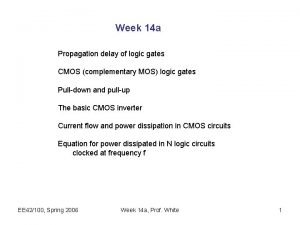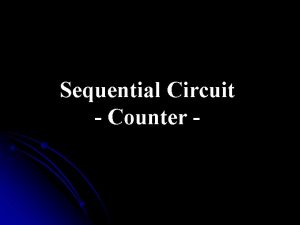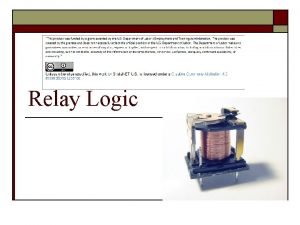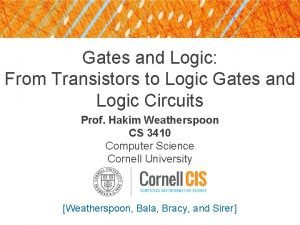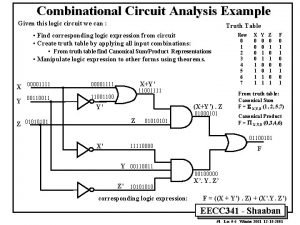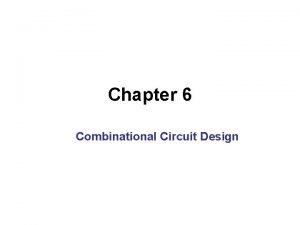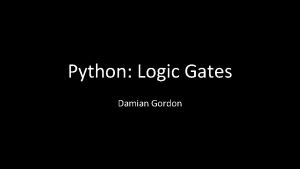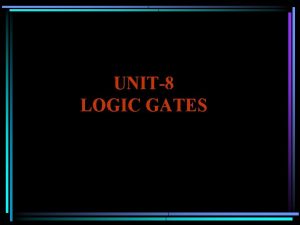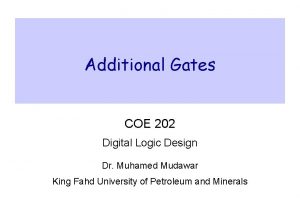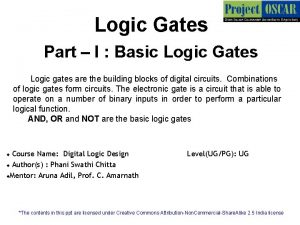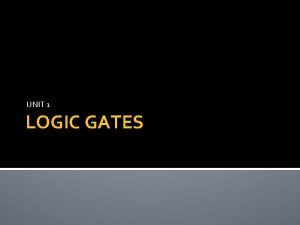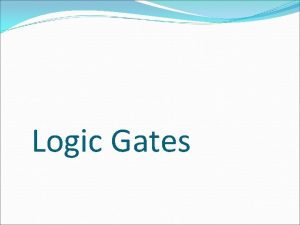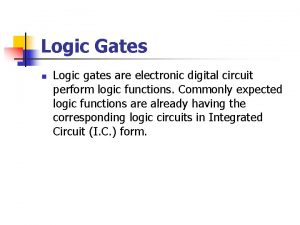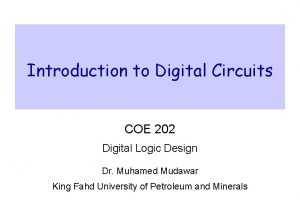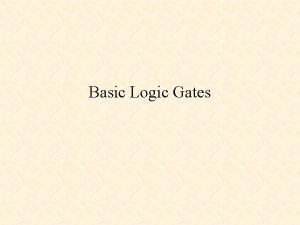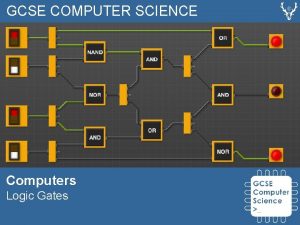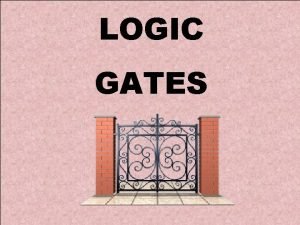Practical Aspects of Logic Gates COE 202 Digital
























- Slides: 24

Practical Aspects of Logic Gates COE 202 Digital Logic Design Dr. Aiman El-Maleh College of Computer Sciences and Engineering King Fahd University of Petroleum and Minerals

Outline v Allowed Voltage Levels v Noise Margin v Propagation Delay v Timing Diagrams v Computing Longest Delay (Critical Path) v Fanin Limitations v Fanout Limitations v Use of buffers v Tri-State drivers Practical Aspects Of Logic Gates COE 202– Digital Logic Design – KFUPM slide 2

Allowed Voltage Levels v Practically, logic 0 is represented by a certain RANGE of Voltages rather than by a single voltage level. v In other words, if the voltage level of a signal falls in this range, the signal has a logic 0 value. v Likewise, logic 1 is represented by a different RANGE of valid voltages. v The range of voltages between the highest logic 0 voltage level and the lowest logic 1 voltage level is an “Illegal Voltage Range”. v No signal is allowed to assume a voltage value in this range. Practical Aspects Of Logic Gates COE 202– Digital Logic Design – KFUPM slide 3

Input & Output Voltage Ranges v Inputs and outputs of IC’s do not have the same allowed range of voltages neither for logic 0 nor for logic 1. v VIL is the maximum input voltage considered a Logic 0. v VOL is the maximum output voltage considered a Logic 0. v VOL must be lower than VIL to guard against noise disturbance and allow for noise margin. v The difference (VIL - VOL) is thus known as the noise margin for logic 0 (NM 0). Practical Aspects Of Logic Gates COE 202– Digital Logic Design – KFUPM slide 4

Input & Output Voltage Ranges v VIH is the minimum input voltage considered a Logic 1. v VOH is the minimum output voltage considered a Logic 1. v VOH must be higher than VIH to guard against noise signals and allow for noise margin. v The difference (VOH - VIH) is thus known as the noise margin for logic 1 (NM 1). Practical Aspects Of Logic Gates COE 202– Digital Logic Design – KFUPM slide 5

Noise Margin v Noise margin is the maximum noise voltage that can be added to the input signal of a digital circuit without causing an undesirable change in the circuit output. Practical Aspects Of Logic Gates COE 202– Digital Logic Design – KFUPM slide 6

Propagation Delay v Consider the shown inverter with input X and output Z. ² A change in the input (X) from 0 to 1 causes the inverter output (Z) to change from 1 to 0. ² The change in the output (Z), however is not instantaneous. Rather, it occurs slightly after the input change. ² This delay between an input signal change and the corresponding output signal change is what is known as the propagation delay. Practical Aspects Of Logic Gates COE 202– Digital Logic Design – KFUPM slide 7

Propagation Delay v A signal change on the input of some IC takes a finite amount of time to cause a corresponding change on the output. v This finite delay time is known as Propagation Delay. v Faster circuits are characterized by smaller propagation delays. v Higher performance systems require higher speeds (smaller propagation delays). Practical Aspects Of Logic Gates COE 202– Digital Logic Design – KFUPM slide 8

Timing Diagrams v A timing diagram shows the logic values of signals in a circuit versus time. v A signal shape versus time is typically referred to as Waveform. v Example: Practical Aspects Of Logic Gates COE 202– Digital Logic Design – KFUPM slide 9

Computing Longest Delay v Each gate has a given propagation delay. v We start at the inputs and compute the delay at the output of each gate as follows: ² The delay at the output of a gate = gate propagation delay + maximum delay at its inputs v Maximum propagation delay from any input to any output is called the Critical Path. v The critical path determines the minimum clock period (T) and the maximum clock frequency (f). v Clock frequency (f) = 1 / T Practical Aspects Of Logic Gates COE 202– Digital Logic Design – KFUPM slide 10

Computing Longest Delay v Example: Assume that delay of each gate is related to number of its inputs i. e. delay of 1 input gate is 1 ns, delay of 2 -input gate is 2 ns. Compute longest propagation delay and maximum frequency. v Longest propagation delay = 7 ns v Maximum frequency = 1 / 7 ns= 143 MHZ. Practical Aspects Of Logic Gates COE 202– Digital Logic Design – KFUPM slide 11

Fanin Limitations v The fanin of a gate is the number of inputs of this gate. v Thus, a 4 -input AND gate is said to have a fanin of 4. v A physical gate cannot have a large number of inputs (fanin). v For CMOS technology, the more inputs a gate has the slower it is (larger propagation delay). For example, a 4 input AND gate is slower than a 2 -input one. v In CMOS technology, no more than 4 -input gates are typically built since more than 4 inputs makes the devices too slow. v TTL gates can have more inputs (e. g, 8 input NAND 7430). Practical Aspects Of Logic Gates COE 202– Digital Logic Design – KFUPM slide 12

Fanout Limitations v If the output of some gate A is connected to the input of another gate B, gate A is said to be driver gate, while gate B is said to be the load gate. v A driver gate may have more than one load gate. v There is a limit to the number of gate inputs that a single output can drive. v The fanout of a gate is the largest number of gate inputs this gate can drive. Practical Aspects Of Logic Gates COE 202– Digital Logic Design – KFUPM slide 13

Fanout Limitations v For TTL, the fanout limit is based on CURRENT. ² A TTL output can supply a maximum current IOL = 16 m. A (milliamps) ² A TTL input requires a current of IIL =1. 6 m. A. ² Thus, the fanout for TTL is 16 m. A/1. 6 m. A = 10 loads. v For CMOS, the limit is based on SPEED/propagation delay. ² A CMOS input resembles a capacitive load (≈10 pf - picofarads). ² The more inputs tied to a single output, the higher the capacitive load. ² The HIGHER the capacitive load, the SLOWER the propagation delay. Practical Aspects Of Logic Gates COE 202– Digital Logic Design – KFUPM slide 14

Fanout Limitations v It is advisable to avoid loads much higher than 8 loads. v Q. What is meant by the DRIVE of a gate? v A. It is the “CURRENT” driving-ability of a gate. In other words, it is the amount of current the gate can deliver to its load devices. ² A gate with high-drive is capable of driving more load gates than another with low-drive. v Q. How to drive a number of load gates that is larger than the fanout of the driver gate? v A. In this case, we can use one of two methods: ² 1. Use high drive buffers ² 2. Use multiple drivers. Practical Aspects Of Logic Gates COE 202– Digital Logic Design – KFUPM slide 15

Use of High-Drive Buffers v A buffer is a single input, single output gate where the logic value of the output equals that of the input. v The buffer provides the necessary drive capability which allows driving larger loads. v Note that the symbol of the buffer resembles the inverter symbol except that it does not have the inverting circle that the inverter symbol has. Practical Aspects Of Logic Gates COE 202– Digital Logic Design – KFUPM slide 16

Use of Multiple Drivers v In general, the large number of load gates is divided among more than one driver such that each of the identical drivers is driving no more than the fanout. v The multiple driver gates (D 1, D 2) are of identical type and should be connected to the same input signals. Practical Aspects Of Logic Gates COE 202– Digital Logic Design – KFUPM slide 17

Tri-State Outputs v Q. Can the outputs of 2 ICs, or 2 gates, be directly connected? v A. Generally, No!!! This is only possible if special types of gates are used. v Q. Why can’t the outputs of 2 normal gates be directly connected? v A. Because this causes a Short Circuit that results in huge current flow with a subsequent potential for damaging the circuit. Practical Aspects Of Logic Gates COE 202– Digital Logic Design – KFUPM slide 18

Tri-State Outputs v This is obvious since one output may be at logic 1 (High voltage), while the other output may be at logic 0 (Low voltage). v Furthermore, the common voltage level of the shorted outputs will most likely fall in the invalid range of voltage levels. v Q. What are the types of IC output pins that can be directly connected? v A. These are pins/gates with special output drivers. The two main types are: ² Open-Collector outputs. ² Outputs with Tri-State capability. Practical Aspects Of Logic Gates COE 202– Digital Logic Design – KFUPM slide 19

Gates with Tri-State Outputs v These gates can be in one of 2 possible states: ² 1. An enabled state where the output may assume one of two possible values: § Logic 0 value (low voltage) § Logic 1 value (high voltage) ² 2. A disabled state where the gate output is in the Hi-impedance (Hi-Z) state. In this case, the gate output is disconnected (open circuit) from the wire it is driving. v An enable input (E) is used to control the gate into either the enabled or disabled state. ² The enable input (E) may be either active high or active low. v Any gate or IC output may be provided with tri-state capability. Practical Aspects Of Logic Gates COE 202– Digital Logic Design – KFUPM slide 20

Output State Illustrations v A generalized output driver can be simply modeled using 2 switches S 1 and S 0. v The output state is defined by the state of the 2 switches (closed -open). v If S 1 is closed and S 0 is open, the output is high (logic 1) since it is connected to the power supply (VDD). v If S 1 is open and S 0 is closed, the output is low (logic 0) since it is connected to the ground voltage (0 volt). Practical Aspects Of Logic Gates COE 202– Digital Logic Design – KFUPM slide 21

Output State Illustrations v If, however, both S 1 is and S 0 are open, then the output is neither connected to ground nor to the power supply. In this case, the output node is floating or is in the Hi- Impedance (Hi-Z) state. v Example: Tri-State Inverter with active high enable Practical Aspects Of Logic Gates COE 202– Digital Logic Design – KFUPM slide 22

Output State Illustrations Practical Aspects Of Logic Gates COE 202– Digital Logic Design – KFUPM slide 23

Condition for Connecting Outputs of Tri-State Gates v Two or more tri-state outputs may be connected provided that at most one of these outputs is enabled while all others are in the Hi-Z state. v This avoids conflict situations where one gate output is high while another is low. v Example: The circuit performs the function Practical Aspects Of Logic Gates COE 202– Digital Logic Design – KFUPM slide 24
 Coe202
Coe202 Pos expression can be implemented using
Pos expression can be implemented using Consensus theorem
Consensus theorem Coe 202
Coe 202 Coe 202
Coe 202 Coe202
Coe202 State diagram truth table
State diagram truth table Coe 202
Coe 202 Coe 202
Coe 202 Coe 202
Coe 202 Coe 202
Coe 202 Coe 202 unlv
Coe 202 unlv Counters courtesy
Counters courtesy Bbkfupm
Bbkfupm Coe logic
Coe logic Practical aspects meaning
Practical aspects meaning Propagation delay
Propagation delay Parking counter using logic gates
Parking counter using logic gates And gate using relay
And gate using relay Timing diagram for logic gates
Timing diagram for logic gates Logic gates using transistors
Logic gates using transistors Logic circuit examples
Logic circuit examples Compound gates in vlsi
Compound gates in vlsi Site:slidetodoc.com
Site:slidetodoc.com Python and gate
Python and gate
